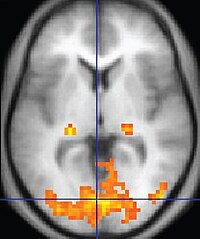
Photo from wikipedia
Functional magnetic resonance imaging (fMRI) of the human spinal cord faces many challenges, such as signal loss due to local magnetic field inhomogeneities. This issue can be addressed with slice‐specific… Click to show full abstract
Functional magnetic resonance imaging (fMRI) of the human spinal cord faces many challenges, such as signal loss due to local magnetic field inhomogeneities. This issue can be addressed with slice‐specific z‐shimming, which compensates for the dephasing effect of the inhomogeneities using a slice‐specific gradient pulse. Here, we aim to address outstanding issues regarding this technique by evaluating its effects on several aspects that are directly relevant for spinal fMRI and by developing two automated procedures in order to improve upon the time‐consuming and subjective nature of manual selection of z‐shims: one procedure finds the z‐shim that maximizes signal intensity in each slice of an EPI reference‐scan and the other finds the through‐slice field inhomogeneity for each EPI‐slice in field map data and calculates the required compensation gradient moment. We demonstrate that the beneficial effects of z‐shimming are apparent across different echo times, hold true for both the dorsal and ventral horn, and are also apparent in the temporal signal‐to‐noise ratio (tSNR) of EPI time‐series data. Both of our automated approaches were faster than the manual approach, lead to significant improvements in gray matter tSNR compared to no z‐shimming and resulted in beneficial effects that were stable across time. While the field‐map‐based approach performed slightly worse than the manual approach, the EPI‐based approach performed as well as the manual one and was furthermore validated on an external corticospinal data‐set (N > 100). Together, automated z‐shimming may improve the data quality of future spinal fMRI studies and lead to increased reproducibility in longitudinal studies.
Journal Title: Human Brain Mapping
Year Published: 2022
Link to full text (if available)
Share on Social Media: Sign Up to like & get
recommendations!